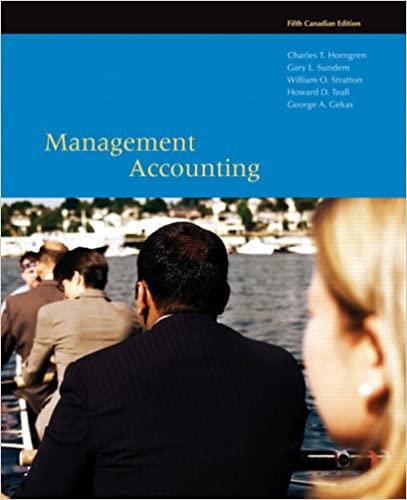The Board of Directors of Atlantic Coast Railroad wants to obtain an overview of the companys operations,
Question:
The Board of Directors of Atlantic Coast Railroad wants to obtain an overview of the company’s operations, particularly with respect to comparing freight and passenger business.
The Board Chair has heard about some new “contribution” approaches to cost allocations that emphasize cost behaviour patterns and so-called contribution margins, contributions controllable by segment managers, and contributions by segments. The Board has hired you as a consultant and has provided you with the following information.
Total revenue in 2006 was \($80\) million, of which \($72\) million was freight traffic and \($8\) million was passenger traffic. Fifty percent of the latter was generated by Division 1; 40 percent by Division 2; and 10 percent by Division 3.
Total variable costs were \($45\) million, of which \($36\) million was freight traffic.
Of the \($9\) million allocable to passenger traffic, \($3.3,\) \($2.8,\) and \($2.9\) million could be allocated to Divisions 1, 2, and 3, respectively.
Total separable discretionary fixed costs were \($8\) million, of which \($7.6\) million applied to freight traffic. Of the remainder, \($80,000\) could not be allocated to specific divisions, although it was clearly traceable to passenger traffic in general.
Divisions 1, 2, and 3 should be allocated \($240,000,\) \($60,000,\) and \($20,000,\) respectively.
Total separable committed costs, which were not regarded as being controllable by segment managers, were \($25\) million, of which 90 percent was allocable to freight traffic. Of the 10 percent traceable to passenger traffic, Divisions 1, 2, and 3 should be allocated \($1.5\) million, \($350,000,\) and \($150,000,\) respectively; the balance was unallocable to a specific division.
The common fixed costs not clearly allocable to any part of the company amounted to \($750,000\).
1. The Board asks you to prepare statements, dividing the data for the company as a whole between the freight and passenger traffic and then subdividing the passenger traffic into three divisions.
2. Some competing railroads actively promote a series of one-day sightseeing tours on summer weekends. Most often, these tours are timed so that the cars with the tourists are hitched to regularly scheduled passenger trains. What costs are relevant for making decisions to run such tours? Other railroads, facing the same general cost picture, refuse to conduct such sightseeing tours. Why?
3. For the purposes of this analysis, even though the numbers may be unrealistic, suppose that Division 2’s figures represented a specific run for a train instead of a division. Suppose further that the railroad has petitioned government authorities for permission to drop Division 2.
What would be the effect on overall company net income for 2007, assuming that the figures are accurate and that 2007 operations are in all other respects a duplication of 2006 operations?
Step by Step Answer:

Management Accounting
ISBN: 9780367506896
5th Canadian Edition
Authors: Charles T Horngren, Gary L Sundem, William O Stratton, Howard D Teall, George Gekas





